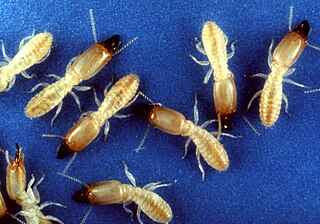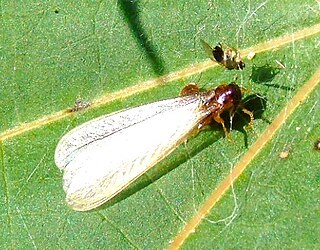
Termites are a group of detritophagous eusocial insects which consume a wide variety of decaying plant material, generally in the form of wood, leaf litter, and soil humus. They are distinguished by their moniliform antennae and the soft-bodied and often unpigmented worker caste for which they have been commonly termed "white ants"; however, they are not ants, to which they are distantly related. About 2,972 extant species are currently described, 2,105 of which are members of the family Termitidae.

The Formosan termite is a species of termite local to southern China and introduced to Taiwan, Japan, South Africa, Sri Lanka, Hawaii, and the continental United States.

Reticulitermes flavipes, the eastern subterranean termite, is the most common termite found in North America. These termites are the most economically important wood destroying insects in the United States and are classified as pests. They feed on cellulose material such as the structural wood in buildings, wooden fixtures, paper, books, and cotton. A mature colony can range from 20,000 workers to as high as 5 million workers and the primary queen of the colony lays 5,000 to 10,000 eggs per year to add to this total.

Amitermitinae is a disputed subfamily of "higher termites" now often merged with the subfamily Termitinae and is considered by ITIS as a synonym; it had previously been placed in the family Rhinotermitidae.

Rhinotermitidae is a family of wood-soil interface feeding termites commonly known as the Subterranean termites. Many members of this family are known pests that can cause extensive damage to buildings or other wooden structures. Most species establish colonies in wood before migrating to the ground to create diffuse nests connecting to multiple pieces of wood, with some taxa such as Coptotermitinae creating mounds or centralized carton nests within wood. All members forage via shelter tubes through the soil to sources of food. In addition, Rhinotermitidae are known for having a higher level of social complexity as compared to other termites. Communication takes place through chemical activity, more specifically through traces of cuticular hydrocarbon (CHC), or semiochemicals, acting as pheromones to send signals to the king and queen of the nest. About 345 species are recognized, among these are severe pests such as Coptotermes formosanus, Coptotermes gestroi, and Reticulitermes flavipes.

Coptotermes gestroi, commonly known as the Asian subterranean termite is a small species of termite that lives underground. Both this species and the Formosan subterranean termite are destructive pests native to Asia, but have spread to other parts of the world including the United States. In Asia, this species is known as the Philippine milk termite.

Reticulitermes is a termite genus in the family Rhinotermitidae. They are found in most temperate regions on Earth including much of Asia and the Middle East, Western Europe, and all of North America.
Ahamitermes is a genus of termites in the family Termitidae containing four species, all of which have a parasitic relationship with termites in the genus Coptotermes. The host and the parasite dwell in separate parts of the mound nest and are mutually antagonistic. The Ahamitermes live in the innermost parts of the nest and feed on the "carton" material with which the galleries are lined which consists of soil particles, chewed wood and cellulose, bound together with saliva and faeces. They are thus dependent on their host for both their food and their home and are not found in any other situations. The genus was first described in 1920 by Eric Mjöberg.
Coptotermes frenchi, the Australian subterranean termite, is a species of termite in the family Rhinotermitidae. Termites are social insects and C. frenchi usually builds its communal nest in the root crown of a tree. From this, a network of galleries extends through the nearby soil, enabling the workers to forage in the surrounding area without emerging on the surface of the ground.

Coptotermes lacteus, the milk termite, is a species of termite in the family Rhinotermitidae, native to Australia. These termites are social insects and build a communal nest in the form of a mound. From this, a network of galleries extends through the nearby soil, enabling the workers to forage in the surrounding area without emerging on the surface of the ground.

Coptotermes acinaciformis is a species of subterranean termite in the family Rhinotermitidae native to Australia. Termites are social insects and build a communal nest. In the case of C. acinaciformis, this is either in the root crown of a tree or underground. From this, a network of galleries extends through the nearby soil, enabling the workers to forage in the surrounding area without emerging on the surface of the ground. This termite can cause substantial damage to trees and the wooden parts of buildings.
Coptotermes elisae, the Papuan plantation termite, is a species of termite in the family Rhinotermitidae. It is native to New Guinea, Indonesia, and Southeast Asia, where it attacks and kills living trees and damages structural timbers.
The Indo-Malaysian drywood termite,, is a species of dry wood termite of the genus Cryptotermes. It is found in Philippines, Australia, Papua New Guinea, Hawaii, and introduced to Sri Lanka. It is the smallest termite species in Australia, with 2.5 – 3.7mm in soldiers.
Coptotermes gaurii, is a species of subterranean termite of the genus Coptotermes. It is native to South India and Sri Lanka. It is a serious pest of tea in Sri Lanka.
Heterotermes indicola, is a species of subterranean termite of the genus Heterotermes. It is native to tropical India, Pakistan and Sri Lanka but has extended its range into the subtropics and warm temperate areas of the Himalayan foothills to altitudes of about 2,000 m (6,600 ft). It causes damage to timber in buildings and is one of the most destructive termites in urban and agricultural areas in the world. Soldiers are about 4.1-4.9mm long. Extracts of garlic and Calotropis procera are known to have termiticidal effects on H. indicola.

Odontotermes horni, is a species of termite of the genus Odontotermes. It is native to India and Sri Lanka. It attacks many dead, decaying trees and fertilized soil. Though nests on ground, they do not construct a termitaria. It is a pest of tea, coconut and sugarcane.
Speculitermes sinhalensis, is a species of termite of the genus Speculitermes. It is native to India and Sri Lanka. It was first found from Vavuniya. They are typical subterranean soil humus feeding termites, which can be found under logs, decaying trees, rocks.

Reticulitermes virginicus is a species of subterranean termite native to North America, found often in the southern United States. It was described in 1907.
Coptotermes heimi is a species of termite in the family Rhinotermitidae. It is found in India, Pakistan and Bangladesh and lives wholly underground.

Odontotermes formosanus is a species of fungus-growing termite in the family Termitidae. It is native to southeastern Asia and was first described from Taiwan. This termite cultivates a symbiotic fungus in a special chamber in the nest. Workers and soldiers gather vegetable detritus which they bring back to the colony, chewing the material to a pulp to make a suitable substrate on which to grow the fungus.










